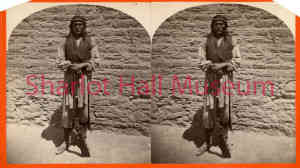Chief Naiche
details
G. H. Rothrock Unknown 1500-0159-0001.jpg IN-A-159 B&W 1500-0159-0001 1500-0159-0001 Stereograph Print 4x6 Historic Photographs 1886 Reproduction requires permission. Digital images property of SHM Library & ArchivesDescription
Chiricahua Apache Chief Naiche, (b. 1857, d. March 16, 1919) whose name in English means "meddlesome one" or "mischief maker", is alternately spelled Nache, Nachi, or Natchez. He was the youngest son of Cochise and his wife Dos-teh-seh (Dos-tes-ey, - "Something-at-the-campfire-already-cooked", b. 1838).
His older brother was Tah-zay aka Chief Taza. Naiche was described as a tall, handsome man with a dignified bearing that reflected the Apache equivalent of a royal bloodline as the son of Cochise.
He was described as being 6'1" in height, which was tall for an Apache. He had three wives, Haozinne, E-Clah-he, and Na-deh-yole, and six children.
Upon the death of his father Cochise in 1874, Naiche's brother Taza became the chief; however, Taza died a few years later in 1876, and the office went to Naiche.
In the 1880s, Naiche and Geronimo successfully went to war together. In 1880, Naiche traveled to Mexico with Geronimo's band, to avoid forced relocation to the San Carlos Apache Indian Reservation in Arizona. They surrendered in 1883 but escaped the reservation in 1885, back into Mexico.
Officially the leader of the last band of renegade Apaches in the Southwest, Naiche and Geronimo surrendered to General Nelson Miles in 1886. Naiche and other Apaches requested to return to Arizona, while still imprisoned in Fort Marion. The US did not allow their return, but Kiowa and Comanche tribes offered to share their reservations in southwestern Oklahoma with the Chiricahua, so Naiche and 295 members of his band moved to Fort Sill, Oklahoma, where they became the Fort Sill Apache Tribe. In 1913, Naiche moved to the Mescalero Indian Reservation in New Mexico where he died of influenza.
Naiche had the reputation of being the finest Indian artist of that period. He painted his pictures on deer skin in color. His subjects were flowers, deer, other wild animals, turkey, and various objects of nature, as he saw them. He also carved canes from wood and painted them in different colors.
Purchase
To purchase this image please click on the NOTIFY US button and we will contact you with details
The process for online purchase of usage rights to this digital image is under development. To order this image, CLICK HERE to send an email request for details. Refer to the ‘Usage Terms & Conditions’ page for specific information. A signed “Permission for Use” contract must be completed and returned. Written permission from Sharlot Hall Museum is required to publish, display, or reproduce in any form whatsoever, including all types of electronic media including, but not limited to online sources, websites, Facebook Twitter, or eBooks. Digital files of images, text, sound or audio/visual recordings, or moving images remain the property of Sharlot Hall Museum, and may not be copied, modified, redistributed, resold nor deposited with another institution. Sharlot Hall Museum reserves the right to refuse reproduction of any of its materials, and to impose such conditions as it may deem appropriate. For certain scenarios, the price for personal usage of the digital content is minimal; CLICK HERE to download the specific form for personal usage. For additional information, contact the Museum Library & Archives at 928-445-3122 ext. 14 or email: orderdesk@sharlot.org.




